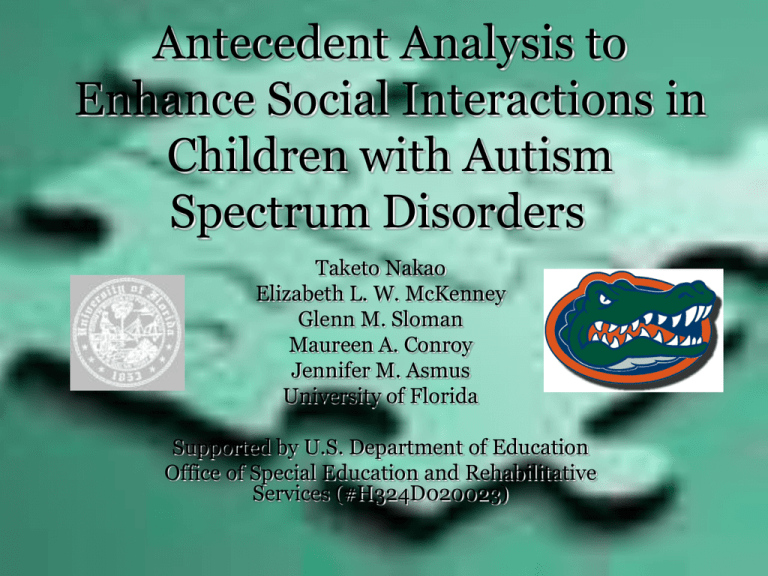Social initiation - University of Florida
advertisement

Antecedent Analysis to Enhance Social Interactions in Children with Autism Spectrum Disorders Taketo Nakao Elizabeth L. W. McKenney Glenn M. Sloman Maureen A. Conroy Jennifer M. Asmus University of Florida Supported by U.S. Department of Education Office of Special Education and Rehabilitative Services (#H324D020023) Project GATORSS • Goals: – To develop a process for increasing the prosocial behavior of young children with Autism Spectrum Disorders (ASD) in early childhood settings. • Development of functional and structural analysis techniques designed to address social skill deficits • Development of individualized social skill interventions using assessment-based behavioral intervention strategies Objectives of Presentation Presentation attendees will learn 3 steps to examine the effects of antecedent interventions on the social behavior of a student with autism : 1. 2. 3. Descriptive observation to identify naturally occurring antecedent events relevant to social interaction A structural analysis to experimentally validate antecedent events identified through the descriptive observation process A treatment plan generated from the results of the structural analysis Presentation Outline • Overview of the literature on antecedent interventions • Review descriptive observation techniques • Describe structural analysis techniques • Present a case study and video examples to illustrate procedures Why Study the Social Behavior of Children with ASD? • Children with autism experience difficulty in three areas: 1) Behavioral excesses and deficits observed as restricted and repetitive behavior 2) Behavioral deficits in display of developmentally and age-appropriate communication and social behavior 3) **** Difficulty with social reciprocity is considered the central and defining feature of autism (NRC, 2001) Why Study the Social Behavior of Children with ASD (cont’d)? • Poor social skills and display of problem behavior often interfere with successful inclusion in early childhood programs (Odom et al., in prep) • Placement in inclusive settings alone will not produce positive and lasting changes in appropriate social behavior by children with ASD (McConnell, 2002) • There is a lack of evidence-based interventions to address and remediate their social skill deficits Antecedent Interventions • An antecedent intervention entails manipulating a setting event or immediate antecedent previously found to influence social behaviors. • Setting events and antecedents often interact with each other to increase the likelihood of social behavior. • Antecedent interventions are often determined by the outcomes of descriptive observation. • Examples: – – – – – changes in activity type the length of time spent in an activity the individual working with the student how statements are made to the student peer group size Why Do We Need More Antecedent Interventions? • Most antecedent intervention research has focused on problem, transition, and academic behavior of children with ASD (Pace, Dunn, Luiselli, Cochran, & Skowron 2005; Cote, Thompson & McKerchar, 2005; Eckert, Ardoin, Daly III, Martens 2002). • Research literature is missing systematic methods of assessment that address the underlying functions and examine the occurrence of social behavior (Stichter & Conroy, 2005). • Next steps are to address the individual needs of children and develop functionally-linked interventions. Method • Descriptive Observation (DO) of Contextual Factors – Approximately 6 hours of direct, sequential recording of behavior in a variety of natural contextual factors within classroom setting – Observation of peer and target child social behavior in presence/absence of different contexts including: activity type, play format, and level of adult engagement – Outcomes of social interactions Method (cont’d) • Experimental Analysis – Structural Analysis (SA) (Cooper et al., 1990; Peck et al., 1997) • Condition: – High preferred social activity and materials – Low preferred social activity and materials – Neutrally preferred social activity and materials • Interventions – Utilization of contextual factors that increase likelihood of appropriate social behavior – Increase appropriate social behavior within identified contexts Case Study: Greg • Participant – Autism – Communicates with simple sentences – Academically precocious : Teachers report superior reading skills – 7 years old – Caucasian • Public Elementary School: Fully Included – 21 typically developing peers and two peers exhibiting developmental disabilities • Identified Concern – Social withdrawal • Very limited interactions with peers across settings Operational Definitions of Social Behavior • Social initiation: – Target child or peer behavior that attempts to evoke a social response, attention, or access to objects/activities. • Response to social initiation: – Target child or peer behavior that acknowledges an initiation within 3 seconds. • No response: – Target child or peer ignores the initiation, and/or continues to engage in the same play behavior (may not have heard/seen initiation). • Interaction: – Sequence of 3 social behaviors between a target child and peer (initiation-response-interaction). The interaction begins with the third behavior in the sequence. Descriptive Observation 1. Approximately 6 hours of videotaped, classroom-based observation 2. Across a variety of contextual factors: -activities (art, snack, computer, books, games, dance/music) -group size (large, small, one-on-one) -level of adult participation (active, passive, or no adult engagement) -amount of adult direction (child or adult-directed activity). 3. Approximately 30 min. of videotaped data for each contextual factor. Descriptive Observation Results • Greg rarely initiated to peers regardless of group size, adult participation, or amount of adult direction. • Initiated the most during structured games (.10 per minute) that had clear rules and expectations, and involved a small group of peers (three). • A similar rate of initiations was found during computer time (.08) • Highest rates of responding to peer initiations during structured games (.43). • Was more likely to respond during small group (.20) or one-on-one activities (.21), and if the activity was child (.27) instead of adult directed (.10). • Was most likely to engage in social interactions (a series of initiations and responses) during structured games. Next Steps for Greg • Conduct an experimental assessment – Structural Analysis (SA) • To determine additional contextual factors that affect the occurrence of social behavior • Link experimental assessment results to intervention SA Procedures • Activity type appeared to affect Greg’s social behavior in the DO • Three activities were chosen for comparison: – Books – Computer – Bingo • Greg played 1 on 1 in each activity with a typically developing peer for 5 minutes SA Procedures Cont’d • The peer student did not initiate to Greg, but responded to all of Greg’s initiations • Two variables were measured: Greg’s rate of initiation and the duration of interactions (sequence of 3 or more social behaviors) Structural Analysis Results Positive Initiations 1.6 1.4 Rate per Minute 1.2 1 computer 0.8 bingo book 0.6 0.4 0.2 0 1 2 3 4 5 6 7 8 9 10 Session Number 11 12 13 14 15 16 17 Structural Analysis – Results (Cont’d) Total Percentage of Social Interaction 100.0 90.0 80.0 70.0 60.0 50.0 Positive Interaction 40.0 30.0 20.0 10.0 0.0 Computer Bingo Condition Book SA: Interobserver Agreement • IOA (IOA collected during 30% of experimental sessions) – Frequency behaviors (initiations) • Mean: 90%; Range: 75-100% – Duration behaviors (interactions) • Mean 99.8%; Range: 99-100% Antecedent Interventions • Based on the results of the DO and SA, we recommend the following interventions for Greg: – Provide small, structured play groups – Include socially-skilled peers to respond to Greg’s initiations, and/or initiate toward him – Play structured and cooperative games – Allow Greg time in preferred activities, such as computer or Bingo, to increase appropriate social behavior Summary • Antecedent intervention research has not focused on appropriate social behavior • Need instruments that provide information for experimental analysis of social behavior • DO and SA gave information about contextual factors affecting Greg’s social behavior • Used to link assessment information to intervention efforts • Findings can lead to the development of more effective interventions to increase social interactions in inclusive settings for young children with ASD For More Information • Contact us at autism@coe.ufl.edu • Check our project website: http://www.coe.ufl.edu/centers/Autism/gatorss











